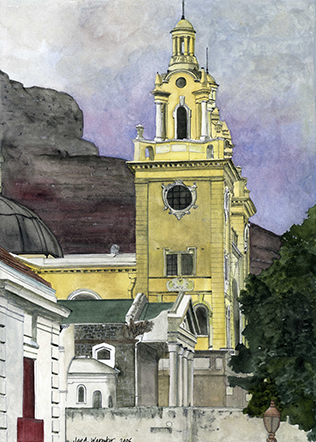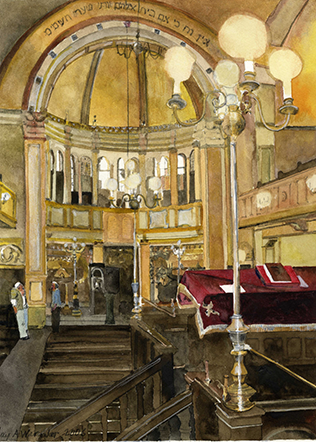 Exterior View (2005), 11” x 15” Watercolor, Jay A. Waronker
Exterior View (2005), 11” x 15” Watercolor, Jay A. Waronker
south africa
New Gardens Synagogue, also known as Tikvat Yisrael (Hope of Israel) (Completed in 1906) |
|

Interior View (2005), 11” x 15” Watercolor, Jay A. Waronker
|
Two historic synagogues positioned literally next to each other can be found in the attractive and popular Gardens district of Cape Town, an inner-city district located just to the south of the central business district and within the higher elevations of the City Bowl. To the north in the distance is the strikingly majestic Table Mountain, which serves as a natural background to the entire site. The Gardens district dates to the mid-17th century when the first garden was laid out. Over the years, the gardens have been changed and expanded, and the district became home to a number of important buildings and monuments. Among these include the Parliament Building down the street on Government Avenue as well as the President’s Residence, National Library, South African Museum, National Art Gallery, Michaelis School of Fine Arts, Planetarium, and the Old Gardens and New Gardens Synagogues.
The Old Gardens Synagogue, more formally called the Tikvat Yisrael Congregation, got its start in 1841, making it the oldest in South Africa and one of the oldest in the Southern hemisphere. On the eve of the Yom Kippur (Day of Atonement) holiday of that year, the first prayer services were held in Helmsley Place on Hof Street, which today forms part of the luxurious Mount Nelson Hotel. It was on this day that the Cape Town Hebrew Congregation was formally founded by seventeen male members. The congregation grew slowly, and by 1849 the community was able to purchase a modest house that was converted into a make-shift synagogue. By the early 1860s, a larger and more accommodating synagogue was needed, and a prominent site in the heart of the Gardens district was purchased. Work began on a building in 1863, Cape Town Jewish community’s first dedicated synagogue, and it was completed the following year.
By the closing years of the nineteenth century, the Tikvat Yisrael Congregation has grown to the extent that a much larger building to accommodate its swelled membership was needed. Joining the already-settled Jews mostly from Western Europe, the immigration of Jews from Eastern Europe at the end of the century led to the dramatic increase in membership of this Cape Town Jewish community. By that point the Old Gardens Synagogue, which had served its Cape Town Jewish congregation for more than forty years, had become too small and outdated for its membership. Once funding had been secured, and the search for an architect and the planning of the building was completed, construction of a new synagogue on the site immediately next door to the old synagogue to the north was undertaken. The result was that a grand if not luxurious sanctuary that could accommodate more than 1,400 seats was erected. This structure also fronts the Gardens promenade. The building was consecrated in September 1905, and for well over a century it has splendidly served its congregation.
The building clearly reads as an important and celebrated civic structure that could be identified as some sort of house of prayer. Yet it includes no elements or features on the exterior, even an overt Jewish marking, that immediate calls attention to itself as a synagogue. It is rather an accomplished and nicely-composed tripartite neo-Baroque design, sometimes even described as “1900-Spainish Colonial” set on a base of full-width front steps. The building, finished in a veneer of buff-colored exterior plaster, features a central massing with a large central round arch containing windows at the second floor above two pairs of entry doors with transoms flanked by panels all divided by classical columns on the ground floor, rusticated base and quoins, and soaring twin towers with various shaped windows. Both towers are topped with a fanciful cupola that is in turn crowned by a tempietto (little temple) capped by a finial. The result is an imposing and impressive edifice that has for well over a century served as a landmark Jewish as well as civic work of architecture in the center of beautiful Cape Town.
Among the prominent interior design features of the double-height sanctuary are the exquisite mosaic panels on the pulpit that flank the ark, the light gray marble floor and wall surfaces, the Baroque-style white plaster detailing contrasted against the richly-stained wooden pews set in rows at the ground-floor for the men and at the women’s U-shaped gallery, the wood-paneled doors and centrally-positioned bimah (table where the Torah is read), the brass candelabra and other lighting fixtures, and the bays of large windows. The ceiling of the sanctuary is vaulted and decorated, and the effect is particularly grand and uplifting.
New Gardens Synagogue is a well-kept synagogue lovingly used and shared by the Tikvat Yisrael Congregation. According the synagogue’s website, since its consecration, there has not been a single day that prayer services were not held in the building. It is a popular tourist destination for travelers from throughout the world to Cape Town, and even in today’s cautious world that affects access to synagogues, visitors are regularly welcomed.
